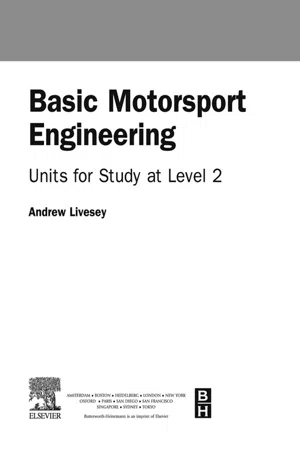![]()
Body and Chassis
KEY POINTS
Most vehicles are front-wheel drive layout; alternative layouts are: conventional, mid-engine, and rear engine.
The chassis is load bearing and must be free of corrosion.
Jacking points and seat belt mounting points are specially reinforced.
Air bags must only be handled following a special procedure.
SIPS and crumple zones are sometimes added to give extra passenger protection.
On most popular cars the body and the chassis are one and the same. Trucks and buses, however, are likely to have the body and the chassis as separate components. Motorsport vehicles may use either arrangement. The chassis is the part to which the engine, gearbox, suspension and other components are attached. The body is the covering for the components, the passengers and the load. The chassis is load bearing, being made from strong steel. The body does not carry a load and may be made from aluminium alloy, or some form of plastic, as well as the more usual steel.
1. VEHICLE LAYOUT
By vehicle layout we mean the position of the engine and gearbox on the chassis in relation to the driving wheels.
Front-wheel drive (FWD) is the most common; the engine and the gearbox are mounted at the front of the car and short driveshafts take the power to the front wheels.
Conventional layout means that the engine is mounted at the front with a gearbox behind it and a propeller shaft takes the power to a rear axle so that the rear wheels are driven.
Rear-engined vehicles drive the rear wheels from a rear-mounted engine (RWD).
FIGURE 1.1 Front engine front wheel drive (FWD)
FIGURE 1.2 Front engine rear wheel drive
Increasingly mid-engine set-ups are becoming more popular in high performance cars, where the engine and the gearbox are mounted in the middle of the vehicle and the rear wheels are driven.
For off-road use four-wheel drive gives better grip. This can be with front or mid-engined layouts.
Nomenclature
4x4 means that the vehicle has a total of four wheels and that it is driven by all the four wheels. 4x4 vehicles may also be called all-wheel drive (AWD), off-road, or all-terrain vehicle.
FIGURE 1.3 Rear engine rear wheel drive (RWD)
2. ADVANTAGES AND DISADVANTAGES
OF DIFFERENT VEHICLE LAYOUTS
Each type of layout has certain advantages and disadvantages when compared to the others, see Table 1.1.
3. CHASSIS
The chassis is the load bearing part of the vehicle. That is to say it carries the weight of the load and the passengers, and locates the engine, transmission, steering and suspension. On most popular cars the chassis and the body are one and the same; but on specialized cars and goods vehicles separate chassis are used. There are three main types of chassis: these are ladder chassis, cruciform chassis and backbone chassis.
TABLE 1.1
Type of Layout | Advantages | Disadvantages |
| FWD | - good traction
- maximum passenger space
| - noise from transmission
- complicated driveshafts
|
| Conventional | - easy to repair
- high level of safety
| - passenger space limited by drive tunnel
|
| Mid-engine | - best weight distribution
- good for 4x4 transmission
| - limited passenger space
- difficult to access engine
|
| RWD | - engine noise behind the driver
- good traction
| - long control cable/rods needed
- luggage space limited — between front wheels and location of fuel tank is difficult
|
FIGURE 1.4 CNC machined chassis of the JCB Diesel record holder car
RACER NOTE
If you look underneath a popular car you will see square sections, like little box girders, connecting the main suspension and transmission parts. These are called the chassis sections; although the vehicle does not have a separate chassis these give extra strength. It is important that the chassis sections are in good condition for the car to be safe.
Ladder chassis — it is called this because of its shape: it looks vaguely like a builder's ladder. It has two side rails connected by cross-members. Ladder chassis are used on trucks and buses as well as vehicles like Land Rovers and some kit cars. The rails which run lengthwise are called longitudinal members; those which go across the vehicle are transverse members. Generally the suspension is attached to the longitudinal rails and the engine will sit between these rails. The gearbox tail housing is attached to a transverse member.
FIGURE 1.5 Ladder chassis
FIGURE 1.6 Cruciform chassis
FIGURE 1.7 Backbone chassis
Cruciform chassis — it is cross-shaped in the middle to give resistance to twisting. This type of chassis is used on some old rare sports cars such as Lea-Francis.
Backbone chassis — it looks roughly like a person's skeleton — a backbone with arms and legs. Lotus and Mazda use this design on their small sports cars (Elise and MX-5); the propeller shaft can fit through the middle of the hollow backbone section.
4. INTEGRAL CONSTRUCTION
Integral construction is also known as unitary construction or monocoque. This is when the chassis and the body are made as one integral unit, that is, as one piece from parts welded together, not as a separate body and chassis. These are often referred to as body shells. The floor, the sills, the roof and the quarter panels are all spot-welded together to form an assembly to which the engine and the running gear are attached. The integral body/chassis is much ligh...








